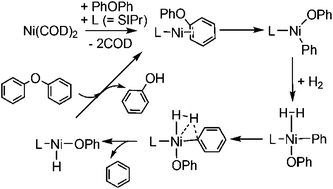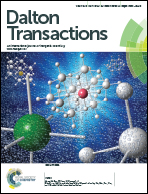Mechanism of Ni N-heterocyclic carbene catalyst for C–O bond hydrogenolysis of diphenyl ether: a density functional study†
Abstract
Catalysts for aromatic C–O bond activation can potentially be used for the lignin degradation process. We investigated the mechanisms of C–O bond hydrogenolysis of diphenyl ether (PhOPh) by the nickel N-heterocyclic carbene (Ni-SIPr) complex to produce benzene and phenol as products. Our calculations revealed that diphenyl ether is not only a substrate, but also serves as a ligand to stabilize the Ni-SIPr complex. The Ni(SIPr)(η6-PhOPh) complex is initially formed before rearranging to Ni(SIPr)(η2-PhOPh), the active species for C–O bond activation. The catalytic reaction has three steps: (i) oxidative addition of Ni(SIPr)(η2-PhOPh) to form [Ni(SIPr)(OPh)(Ph)]0, (ii) σ-complex-assisted metathesis, in which H2 binds to the nickel to form [Ni(SIPr)(OPh)(Ph)(H2)]0, and then benzene (or phenol) is eliminated, and (iii) reductive elimination of phenol (or benzene) and the binding of PhOPh to regenerate Ni(SIPr)(η2-PhOPh). As the rate determining step is the oxidative addition step (+24 kcal mol−1), we also calculated the free energy barriers for the oxidative addition of diaryl ether containing a trifluoromethyl electron withdrawing group (PhOC6H4CF3) and found that C–O bond activation at the carbon adjacent to the aryl ring that contains the electron withdrawing substituent is preferred. This is in agreement with the experimental results, in that the major products are phenol and trifluoromethylbenzene. Moreover, the hydrogenation of benzene via Ni(SIPr)(η2-C6H6) requires a high energy barrier (+39 kcal mol−1); correspondingly, the hydrogenation products, e.g. cyclohexane and cyclohexadiene, were not observed in the experiment. Understanding the reaction mechanisms of the nickel catalysts for C–O bond hydrogenolysis of diphenyl ether will guide the development of catalytic systems for aromatic C–O bond activation to achieve the highest possible selectivity and efficiency.


 Please wait while we load your content...
Please wait while we load your content...